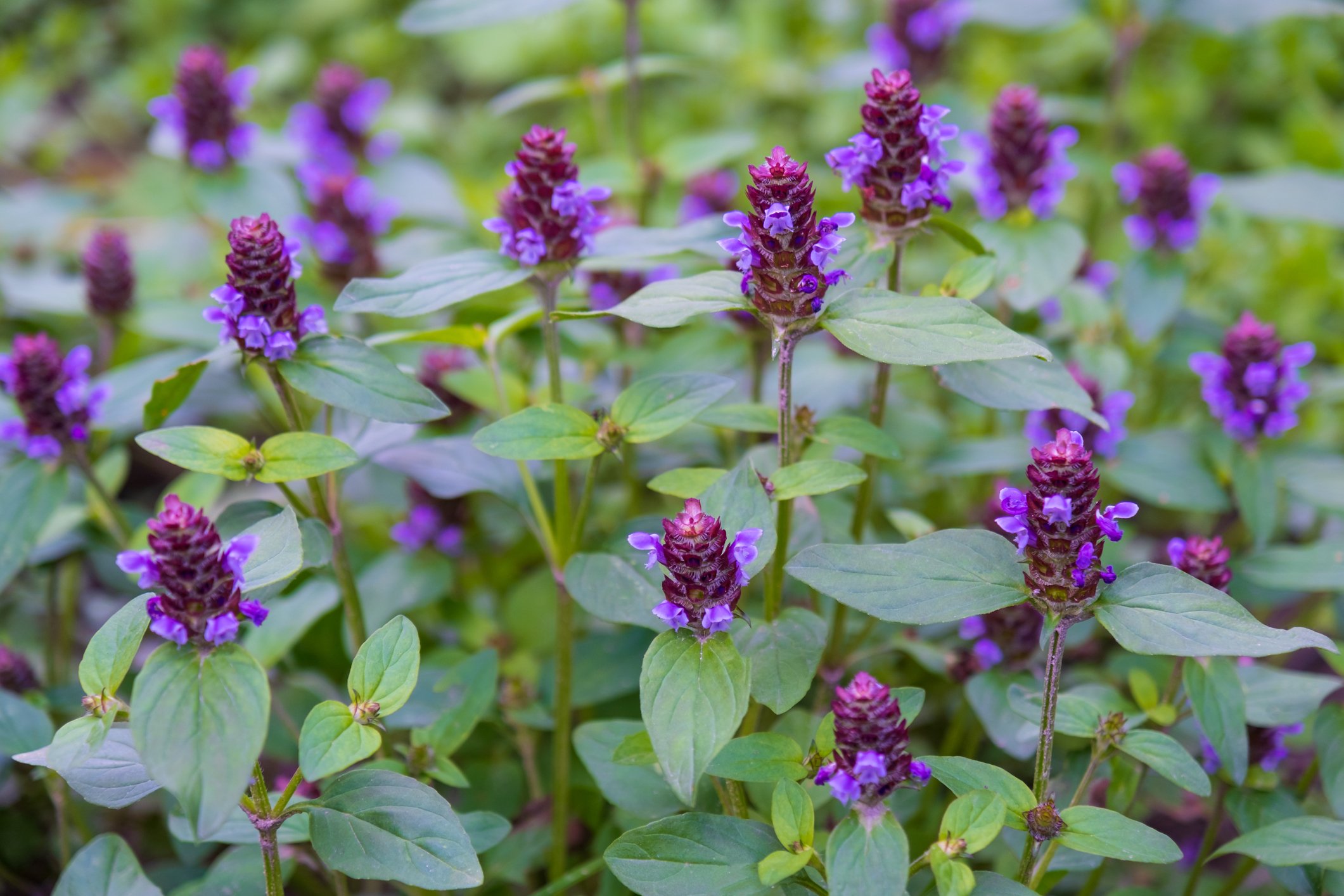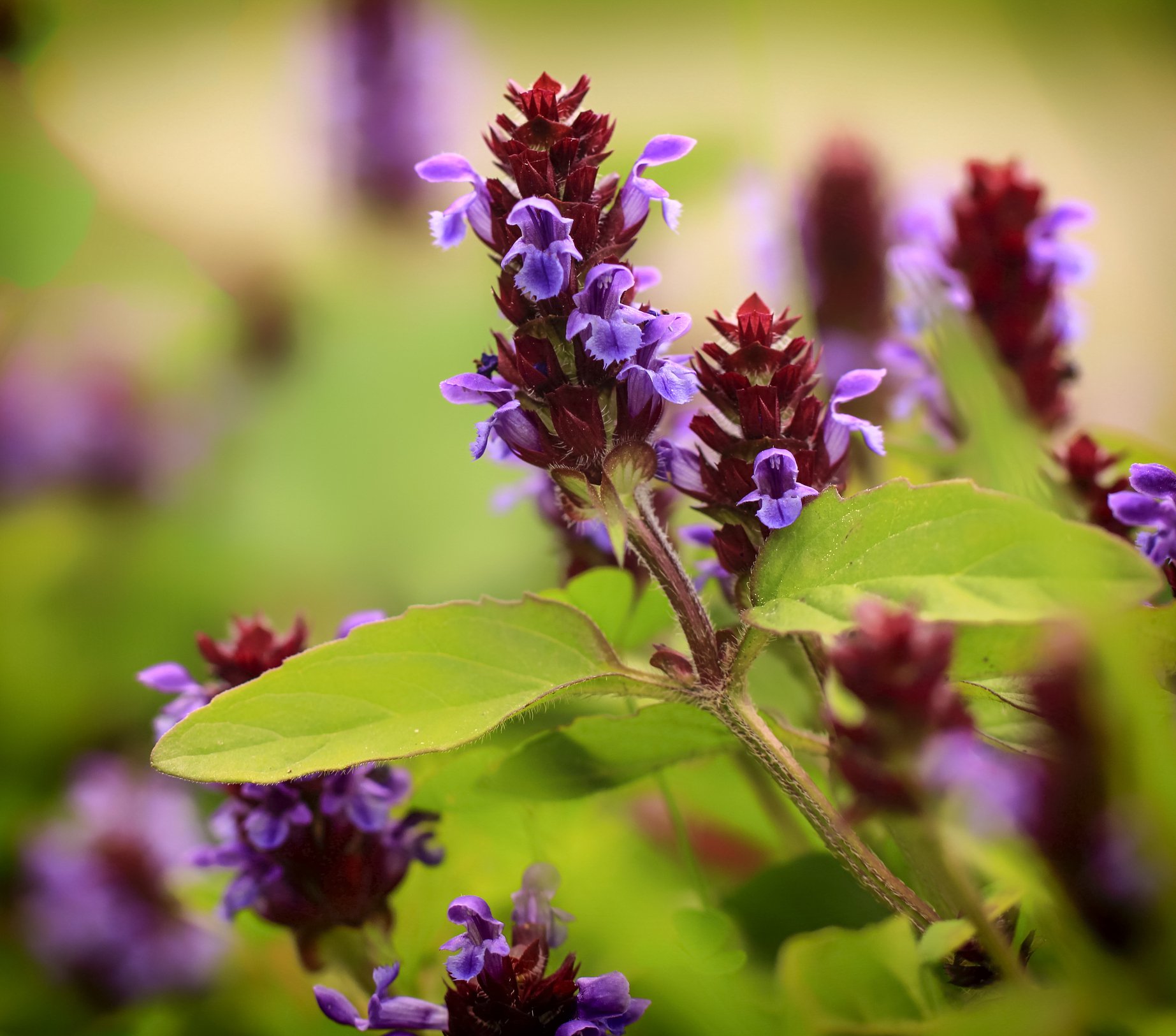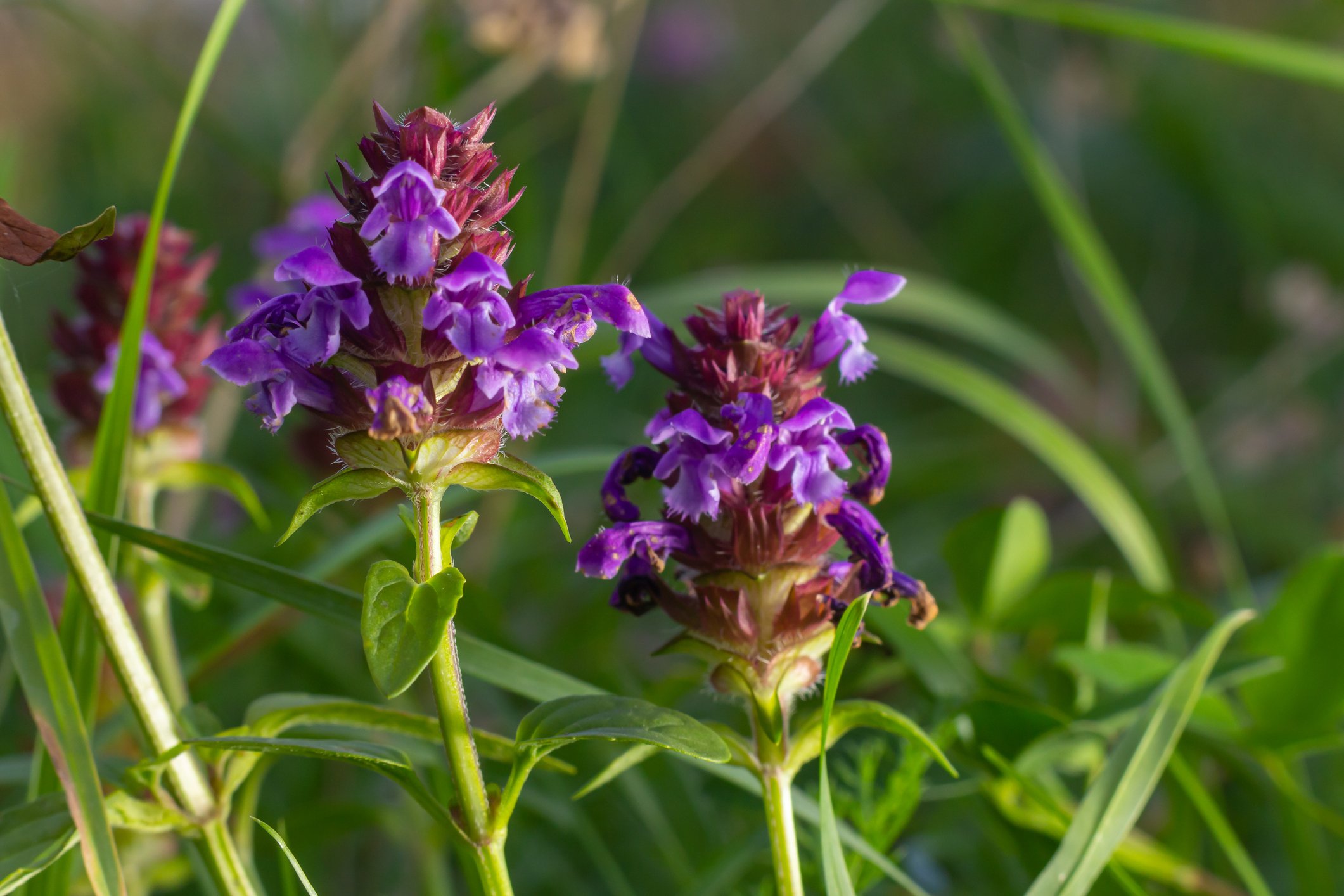
Self Heal
Self Heal (Prunella vulgaris)
Plant Family
Lamiaceae.
Other significant names
All-heal
Prunella
Parts used
Flowering herba
Typical forms of prescription
Infusions
Infused oils
Vinegars
Self-Heal (Prunella vulgaris) – Clinical Snapshot
Primary Actions
Vulnerary
Anti-inflammatory
Astringent
Styptic
Tonic
Primary Indications
Wounds & Skin: Cuts, wounds, haemorrhoids
Mouth & Throat: Sore throats, sore gums, glossitis, ulcers
Digestive: Oral and digestive inflammations
Other: Headaches (used topically)
⚠️Cautions / Safety⚠️
None known
Prunella vulgaris
Phytochemistry and Pharmacology
Rosmarinic Acid
Action: Anti-inflammatory, antiviral, antioxidant
Use: One of the most active compounds in Prunella, rosmarinic acid helps soothe inflamed tissues, modulate immune responses, and provides strong antiviral activity, especially useful in herpes simplex, cold sores, throat infections, and gut inflammation. It also supports skin healing when applied topically.
Flavonoids
Includes: Rutin, quercetin, luteolin
Action: Antioxidant, capillary protective, anti-inflammatory
Use: These flavonoids help stabilise blood vessels, reduce oxidative damage, and support immune modulation — especially useful in conditions involving lymphatic congestion, glandular swelling, or minor bleeding.
Triterpenoids
Includes: Oleanolic acid, ursolic acid
Action: Anti-inflammatory, antiviral, antimicrobial
Use: These compounds contribute to Prunella’s ability to fight infections, reduce inflammation, and support tissue regeneration. They're especially relevant in skin and mucosal healing, including topical salves for wounds, gargles, or herpes outbreaks.
Phenolic Acids
Includes: Caffeic acid, chlorogenic acid
Action: Antioxidant, tissue-protective
Use: These phenolics add to Prunella’s overall cooling, cleansing, and detoxifying effects, supporting its traditional use in fevers, sore throats, infections, and lymphatic congestion.
Polysaccharides
Action: Immunomodulating, demulcent
Use: These gentle, soothing compounds help balance immune activity, promote tissue repair, and may offer mild demulcent effects for the throat, urinary tract, or gut. They support Prunella’s reputation as a rebuilding herb after illness or stress.
Tannins
Action: Astringent, anti-inflammatory
Use: Present in modest amounts, tannins help tone tissues and reduce inflammation, useful for bleeding gums, mouth ulcers, diarrhoea, and skin infections.
Traditional use
Self-Heal, also known as Prunella vulgaris, has a long-standing history in traditional European and Chinese medicine. The name itself reflects its reputation as a panacea, "all-heal”, and it was historically considered a remedy for nearly every ailment. Medieval herbalists prized it as a powerful internal and external wound herb. John Gerard, the 16th-century herbalist, declared that “there is not a better wound herb than that of Self Heal,” highlighting its broad use for cuts, ulcers, and inflamed tissues.
It was commonly infused or decocted as a tonic to support recovery from illness and injury, especially those involving the mouth, throat, and nervous system. In folk practices, it was used to soothe sore throats, calm feverish conditions, and promote clarity of mind. The Doctrine of Signatures, associating a plant’s form with its function, led to its use for brain-related ailments due to its flower’s resemblance to a gaping mouth or hooded head. Culpeper noted its value in treating headaches when applied topically, often combined with rose oil for additional cooling effects.
Clinical discussion
Though not widely used in contemporary Western herbal medicine, Prunella vulgaris remains a highly valuable, underutilised ally, especially as a local, easily foraged vulnerary. It has notable astringent, antibacterial, anti-inflammatory, and lymphatic properties, making it ideal for acute first-aid care and deeper systemic support.
Topically, Self Heal is especially suited for minor wounds, burns, abrasions, and slow-healing or infected injuries. It may be applied as a poultice, salve, or infused oil. Internally, it can support the healing of ulcers, sore throats, gum infections, and swollen glands. Its gentle lymphatic action supports the clearance of congestion in the neck and throat region.
Self Heal’s tannins contribute to its drying, toning effect, which is particularly beneficial for weepy, inflamed tissues. While mild in flavour and action, it can be safely used by a wide range of populations, including children and the elderly, for inflamed mucosa or general tissue repair.
Modern herbalists may consider Self Heal in formulas for:
Bleeding gums and mouth ulcers
Tonsillitis and sore throats
Wound healing and skin infections
Lymphatic congestion in the head and neck
Early-stage viral infections (e.g., cold sores or flu-like symptoms)
In Traditional Chinese Medicine (TCM), Prunella vulgaris is used to “clear Liver fire,” cool inflammation, and disperse swellings, particularly in the throat and eyes.
Cultivation/harvesting
Prunella vulgaris is a hardy, creeping perennial that thrives in meadows, woodland edges, lawns, and disturbed soils. It prefers moist, well-drained soil and partial sun but is highly adaptable and will often self-seed freely once established.
Harvest the aerial parts for medicinal use when the plant is in full bloom, typically between late spring and midsummer. Choose a warm, sunny day after the dew has dried to ensure optimal potency and easier drying. Both the leaves and purple flower spikes are used. Dry in small bunches in a well-ventilated area or dehydrate at low heat, then store in airtight jars away from light and moisture.
Frequent cutting during flowering will encourage further blooming, making Self Heal an excellent addition to herbal gardens with a dual purpose: medicine and pollinator support.
Key Botanical Features of Self-Heal (Prunella vulgaris)
Prunella vulgaris, commonly known as Self-heal or Heal-all, is a low-growing perennial herb in the Lamiaceae (mint) family, traditionally used in herbal medicine for wound healing and immune support. It is widespread and commonly found in meadows, lawns, and woodland edges.
Growth Habit
Type: Perennial herb.
Height: Typically 10–30 cm (4–12 inches) tall.
Form: Creeping or upright, spreading by rhizomes.
Stems: Square-shaped, green to reddish, and sometimes hairy.
Leaves
Arrangement: Opposite on the stem.
Shape: Lanceolate to ovate, with smooth or slightly serrated edges.
Size: Usually 2–5 cm long.
Surface: Slightly hairy or smooth, depending on growing conditions.
Flowers
Type: Tubular, two-lipped (bilabiate) flowers, typical of the mint family.
Colour: Purple to violet, sometimes pinkish.
Arrangement: Dense terminal spikes (cone-shaped inflorescence) resembling a small pinecone.
Blooming Season: Late spring to early autumn.
Pollination: Attracts bees and butterflies.
Roots
Type: Fibrous root system with spreading rhizomes, allowing it to colonise ground surfaces quickly.
Habitat & Growth Conditions
Native Range: Widely distributed across Europe, Asia, and North America.
Habitat: Found in meadows, grasslands, forest edges, and disturbed areas.
Soil: Prefers moist, well-drained soils, but is highly adaptable.
Sunlight: Grows in full sun to partial shade.
Sustainability/conservation
Common British wildflower. Least concern.




Sources
Bartram, T. (1998). Bartram’s Encyclopedia of Herbal Medicine. Constable.
Fisher, C. (2009). Materia Medica of Western Herbs, (2018 edition). Finchley Road, London. Aeon Books.
Hedley, C & Shaw, N. (2020). A herbal book of making and taking. Finchley Road, London. Aeon Books.
Hoffmann, D. (2003). Medical Herbalism: The Science and Practice of Herbal Medicine. Healing Arts Press.
McIntyre, A. (2019). The complete herbal tutor, revised and expanded edition. Finchley Road, London. Aeon Books.
Plants of the World Online | Kew Science. (n.d.). Plants of the World Online. https://powo.science.kew.org/
Disclaimer: This page is for educational purposes only. Consult a qualified medical herbalist before using herbs, especially during pregnancy, when trying to conceive, while breastfeeding, for medical conditions, or with children.
Read the full disclaimer → Medical Disclaimer.





